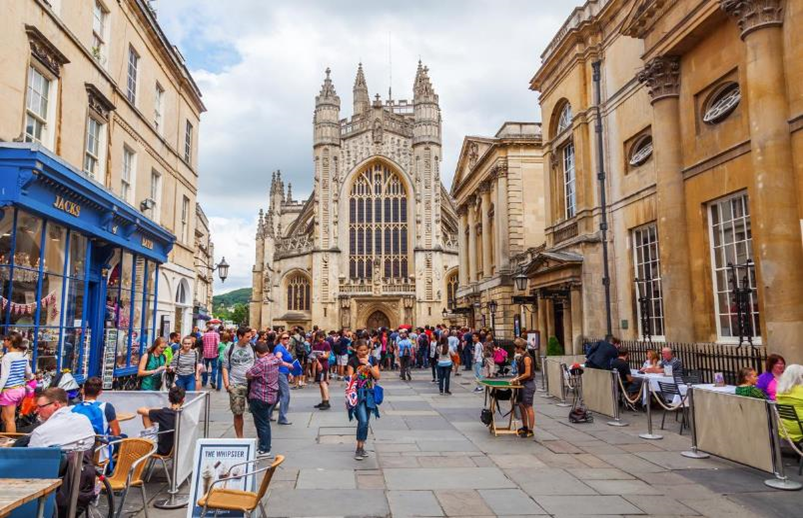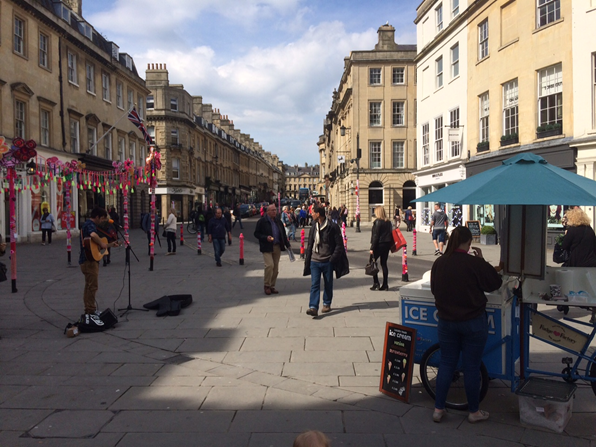Bath Clean Air Zone
Transport is widely acknowledged to be a key contributor to poor air quality. Introduced in March 2021, the Bath Clean Air Zone (CAZ) charges all higher emission vehicles, except private cars and motorcycles, to drive into, within, or near the city centre. The scheme is primarily aimed at reducing nitrogen dioxide levels.
We monitor the scheme on a quarterly basis. The April to July 2021 Monitoring Report (directly after implementation) identified that the CAZ is having its intended effect of improving vehicle compliance, changing behaviours and improving the city’s air quality in general. The average nitrogen dioxide concentrations across monitoring sites within the CAZ were found to be 12.6% lower than the same period in 2019, with similar reductions found in the Bath urban area outside the zone’s boundary. Traffic flows are 9% lower in the CAZ area, compared with the same period in 2018, although it is noted that the coronavirus pandemic continues to impact travel behaviour.
Delivery timescales: Implemented
Other themes supported:
Liveable Neighbourhoods
A Liveable Neighbourhood is a simple and cost-effective way to reduce through-traffic while maintaining vehicle access to homes and businesses. Liveable Neighbourhoods promote and prioritise walking, cycling and public realm improvements, without disadvantaging people with mobility restrictions. Liveable Neighbourhoods are not new. They have been successfully introduced across the world to improve residential environments and solve traffic issues. They are developed collaboratively with communities, to turn streets that are noisy, polluted and dangerous into pleasant, safe places to live and work.
Liveable Neighbourhoods will breathe new life into residential areas by reducing the dominance of motor vehicles within our communities. They rebalance highway space, so that motor vehicles have only the space they absolutely require, and the remainder is used to create safer, more pleasant outdoor environments in which people can relax, socialise and enjoy spending time. They are places where people can safely walk and cycle, and allow local high streets to become livelier and more prosperous places.
The following delivery areas have been identified for the first phase of Liveable Neighbourhoods. This includes locations in the wider North East Somerset area, as improving local connections will increase connectivity to transport hubs, which will have an impact on onward travel to Bath.
- Mount Road
- Great Pulteney Street / St Johns Road area
- Whitchurch and Queen Charlton
- Circus / Lower Lansdown / Marlborough Building / Royal Victoria Park / Cork Street area
- Oldfield Lane and First / Second / Third Avenues
- Walcot (Phase 1): London Road, Snow Hill, Kensington Gardens and adjacent roads
- Church Street and Prior Road Park
- Chelsea Road
- Entry Hill
- Southlands
- Morris Lane / Bannerdown
- New Sydney Place
- Edgerton Road / Cotswold Road
- Temple Cloud
- Lyme Road / Charmouth Road
The detail of the measures in each of these locations will be informed by community engagement, in collaboration with Ward members, residents’ associations, businesses, other organisations and individual advocates in the areas concerned.
Delivery timescales: Short- to medium-term
Other themes supported:
Bath City Centre Security Project

View of Abbey Churchyard and Bath Abbey
Keeping our streets and spaces safe and secure from the threat of terrorism is an important part of our role as your local council. Since 2016, we have worked closely with Avon and Somerset Police and Counter Terrorism Security Advisors on protection work designed to improve overall public safety and strengthen protection in areas of high footfall.
In 2020, we put forward a proposal to introduce permanent measures in Bath City Centre, with the purpose of improving security. The aim was to achieve a viable balance between the need for security to reduce the risk of vehicle-borne terrorist attacks, and the needs of local residents, businesses and service providers for vehicle access to the inner city core area. The measures include access restrictions to motor vehicles during certain times of the day, in particular on streets with the highest footfall in the city, and purpose-designed street furniture. As part of these proposals, detailed consideration is being given to special vehicles or road uses (such as Blue Badge holders, Emergency Service vehicles, and postal service vehicles).
Delivery timescales: Short-term
Other themes supported:
Bath High Street Renewal Programme

View of Bath High Street
We have secured £1.24m Love our High Streets grant funding from the Combined Authority, to be spent over five years on improving Bath City Centre, including Milsom Street and Kingsmead Square. This programme aims to improve the experience for both residents and visitors, which includes pedestrian and street furniture improvements.
The Bath High Street Renewal project will support our Liveable Neighbourhoods ambitions and help transform two key areas in the city into accessible, vibrant areas to shop, eat and relax.
A range of measures, including bringing vacant shops back into use for cultural and arts initiatives or as pop-up shops, adding parklets (transforming parking into community spaces including benches and planters), green wall planting and encouraging outdoor seating for cafes and restaurants, as well as a programme of public art, events and performance is proposed to improve the high street experience for residents and visitors.
We are looking to secure further funding to support a Phase 2 project to bring animation, temporary arts and commercial uses to vacant shops in Bath, Keynsham and Midsomer Norton.
Delivery timescales: Short- to medium-term
Other themes supported:
Freight consolidation, e-cargo bike and last-mile delivery support
Business e-Cargo bike loans
Since its inception in October 2020, the business e-cargo bike loan project has seen 20 participants. Each of the four e-cargo bikes owned by the Council may be borrowed for up to five months in a “try before you buy” free loan scheme. These bikes are managed in the same manner as the public loan bike scheme. Feedback from users of the scheme was that they saved twice the car mileage as the bike mileage they actually used, because they could use cycle paths and combine trips.
CAZ e-cargo bike local delivery service
From January 2022, we will be subsidising approved e-cargo bike operators to offer discounted parcel rates, making e-cargo bike delivery competitive with the rates offered by traditional couriers. This will help take more polluting vans off city-centre streets, to improve air quality and reduce congestion. Different e-cargo bike operators will offer different services, so when the scheme launches, you can talk directly to our approved operators to find out how they can best serve your needs. You will receive a discounted rate from the e-cargo operator, similar to your normal van delivery rate, and we will make up the difference.
We recently won £700,000 of funds for this initiative from central Government, and this will be spent on subsidising parcel rates and on promoting the scheme. This will initially run as a trial for six months, and then a further 30 months if it’s successful. From there, with growing demand, it is assumed that e-cargo bike operators will be able to continue to offer competitive rates without our help.
Last-mile delivery
We have supported the courier company Wego since January 2020 through a Go Ultra Low grant to provide a last-mile delivery service in and around Bath’s Clean Air Zone. With the operation now using two micro-consolidation hubs to the east and west of the CAZ, the service typically delivers over 1,500 parcels per month to the final destination of a much longer logistics journey.
Delivery timescales: Implemented
Other themes supported:
M4 to Dorset Coast Connectivity Study
As part of the government’s Road Investment Strategy (RIS2) the DfT committed to a strategic study on-road connectivity between the M4 corridor and the Dorset Coast. The A36 and A46 form part of the Strategic Road Network (SRN), comprising England’s motorways and some A roads, and both serve the B&NES area. The study is currently being carried out by National Highways and stems from concerns raised by stakeholders that the volume of traffic using the A36 and A46 is leading to problems of congestion, road safety and air quality, with impacts on the Bath World Heritage Site. The study is therefore considering whether there is a case to adopt alternative corridors as the main strategic route for the area.
To date, a number of potential different routes have been identified that could provide alternatives to the A36 and A46. National Highways are considering a range of potential options, both in terms of the objectives of the scheme and in terms of deliverability, and report the recommendations in late summer 2022.
Delivery timescales: Short-term
Other themes supported:
